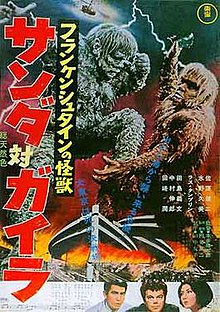| The War of the Gargantuas | |||||
|---|---|---|---|---|---|
 Theatrical release poster | |||||
| Japanese name | |||||
| Kanji | フランケンシュタインの怪獣 サンダ対ガイラ | ||||
| |||||
| Directed by | Ishirō Honda | ||||
| Screenplay by |
| ||||
| Produced by |
| ||||
| Starring | |||||
| Cinematography | Hajime Koizumi[1] | ||||
| Edited by | Ryohei Fujii[1] | ||||
| Music by | Akira Ifukube[1] | ||||
Production companies | |||||
| Distributed by | Toho (Japan) Maron Films (United States) | ||||
Release dates |
| ||||
Running time | 88 minutes[2] | ||||
| Countries | Japan United States | ||||
| Language | Japanese[a] | ||||
| Box office | $3 million (United States)[5] | ||||
The War of the Gargantuas (Japanese: フランケンシュタインの怪獣 サンダ対ガイラ, Hepburn: Furankenshutain no Kaijū: Sanda tai Gaira, lit. 'Frankenstein's Monsters: Sanda vs. Gaira') is a 1966 kaiju film directed by Ishirō Honda, with special effects by Eiji Tsuburaya. Referred by film historian Stuart Galbraith IV as a "quasi–sequel" to Frankenstein vs. Baragon,[1] the film was a Japanese-American co-production; it was the third and final collaboration between Toho Co., Ltd and Henry G. Saperstein.[6][7] The film stars Russ Tamblyn, Kumi Mizuno and Kenji Sahara, with Yû Sekida as Sanda and Haruo Nakajima as Gaira. In the film, scientists investigate the sudden appearance of two giant hairy humanoid monsters that culminates in a battle in Tokyo.
The script's final draft was submitted in April 1966. Tab Hunter was originally hired by Saperstein, choosing to replace Nick Adams. However, Hunter was replaced by Tamblyn during pre-production. Honda's contract was not renewed and he had to seek employment by speaking to Tanaka on a film-by-film basis. Honda, Saperstein, and chief assistant Seiji Tani noted that Tamblyn was difficult to work with. Tamblyn did the opposite of Honda's instructions, and improvised his lines without Honda's approval. Principal photography began in May 1966 and wrapped in June 1966, with effects photography concluding in July 1966.
The War of the Gargantuas was theatrically released in Japan on July 31, 1966, followed by a theatrical release in the United States on July 29, 1970 on a double feature with Monster Zero. Since its release, the film has been regarded as a cult classic, drawing admiration from artists such as Brad Pitt, Hajime Isayama, Guillermo del Toro, Quentin Tarantino and Tim Burton.
- ^ a b c d e f g Galbraith IV 2008, p. 231.
- ^ Cite error: The named reference
DVD Talk Felixwas invoked but never defined (see the help page). - ^ Ryfle & Godziszewski 2017, p. 232.
- ^ Cirronella, Jim (March 30, 2014). "Interview: Russ Tamblyn and Haruo Nakajima". Toho Kingdom. Archived from the original on March 8, 2021. Retrieved April 21, 2018.
- ^ Ryfle 1998, p. 125.
- ^ Ryfle & Godziszewski 2017, p. 222.
- ^ Ryfle & Godziszewski 2017, p. 231.
Cite error: There are <ref group=lower-alpha> tags or {{efn}} templates on this page, but the references will not show without a {{reflist|group=lower-alpha}} template or {{notelist}} template (see the help page).